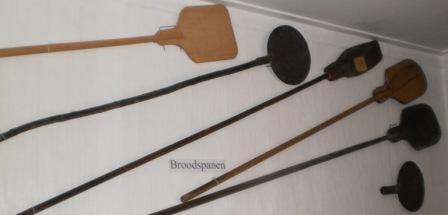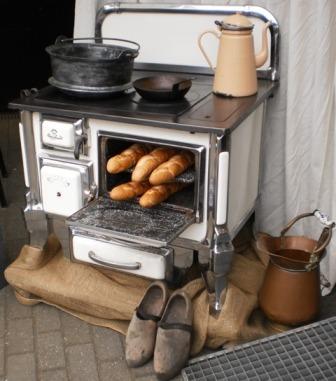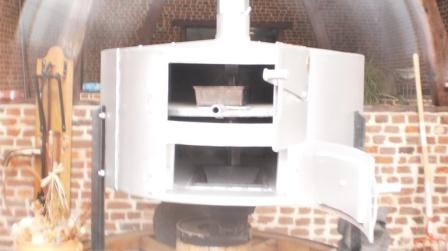The necessary baking heath is used in three ways: by conduction (from the hotplates in), convection (circulation by rising hot air)and by radiation (from the dome).
'Bannetons' or (braided) rice baskets are used to let the dough rise. Cover it with a cloth dusted with flour, so you can easily remove the bread. The baskets are obviously not placed in the oven, but they draw a beautiful print in the crust.
 I always leave dough in a tin or let it rise on a baking sheet. That's easier to shoot the loafs into the oven. And prevents dough 'falls' (collapses) by the shocks of the manipulation. (The by fermentation formed gases escape, and the volume decreases.) Low cake pan or baking tins will do.
I always leave dough in a tin or let it rise on a baking sheet. That's easier to shoot the loafs into the oven. And prevents dough 'falls' (collapses) by the shocks of the manipulation. (The by fermentation formed gases escape, and the volume decreases.) Low cake pan or baking tins will do.
If you bake the bread without loaf pans (bread molds), then leaf enough space between them so they do not stick while they rise. We call it shooting because the bread is on a kind of large, flat spoon with a (round) board or plate on a long stalk. With this you can reach the back of the oven. The shooting is the forward and then immediately fast retreating movement with the spoon to transfer the dough to the oven floor.
You see those shovels still in use to get pizzas in and out wood-fired ovens.
A peel like this was also called pole (the French pale (oar, paddle board) from the Latin pala (spade, shovel)).
 The air in the oven is heated by the radiant heat from the walls of the cooling oven. This means that the bread is baked in an oven which is becoming cooler.
The air in the oven is heated by the radiant heat from the walls of the cooling oven. This means that the bread is baked in an oven which is becoming cooler.
You can leave a row of embers behind the door in the oven. The rising heat acts as a kind of door as long as the actual door is open in order to glide bread in the oven.
The usually quite loose door can be sealed with loam or old newspapers.
I also put a bowl of water in the oven. Moist air conducts heat better. ( Think of a sauna.) And when the air is humid, the bread losses less moisture in the air, and will be less dry.
A large rye bread can need 1.5 to 2 hours to be well done.
After baking the bread the oven is still hot enough to bake for pie, sandwiches, pizza .... so you can still use the heat once more, also e.g. to dry food or herbs.
The bread crust should be firm and hard. If you tap it, it should sound hollow.
Our bread was placed on grids to cool, and once or twice painted with water (milk or egg as well) to make the crust shine. Bread was usually allowed to rest for a day before eating. This improves the taste. ( Today, some would already dare mention this as 'old bread'.) Then it could be stored easily for one week cool and dark in a large kettle. Of course there was only cut off what was eaten: bread to the chest, and with the bread knife slices are cut off.
Lay the wood for the next heating in the oven. Thus, the last work of the cooling oven ensure a smooth start to the new firing to come. The wood is completely dry, and is ready to use. (What is too much you take out of course.)
Potbrood is bread as it was cooked in a cast iron pot with lid (also known as a Dutch oven) by the peasant settlers in South Africa in a pit in the ground. Under, around and on the pot are hot (char) coals and embers scattered. It is still popular on a braai (barbecue).
The Dutch oven is a heavy cast iron pot with a handle (and used to have 3 feet) which is wider at the top than on the bottom. Before the first use, he should be thoroughly and hot cleaned and greased (or oiled).
Iron wood fired bread oven
 After the brick oven we had an iron bread oven. Two horizontal revolving iron wheels with refractory bricks bottom, around them a cloak. At the bottom a small fire compartment. Around the casing is a second one. The space between the two coats was the chimney, which drained the smoke trough the top chimney. With control valve and a thermometer. Huge improvements. And it needed much less wood.
After the brick oven we had an iron bread oven. Two horizontal revolving iron wheels with refractory bricks bottom, around them a cloak. At the bottom a small fire compartment. Around the casing is a second one. The space between the two coats was the chimney, which drained the smoke trough the top chimney. With control valve and a thermometer. Huge improvements. And it needed much less wood.
Making bread
For bread you mix crushed cereal and (lukewarm) water.
In order to make it softer and lighter we use leaven or yeast.
This can eventualy additionaly been fed with sugar.
And for the taste you add some salt.
You can use various types of flour, and add all sorts of things: raisins, egg, milk, butter, oil, chocolate, onions, cheese, nuts, ...
It is important that you properly knead enough the base dough (about 20 minutes).
Let it rise covered from drafts 30 to 40 minutes at room temperature. Depending on amount of yeast and nutrients, and the temperature, the initial rise (up to double the volume of dough) may take several hours.
Here after you can still add things, then knead again and let rise again in the load pan (or on the baking sheet) another 30 to 40 minutes. ( A form is not required, but you should be able to take the risen dough and put it in the oven. So you need at least a clay or iron griddle.)
Then slide it in a hot oven ( 250-280°C) for about 35 minutes to bake.
Bread is done at any temperature of at least 100 degrees. The lower the firing temperature the softer the crust. Steamed bread has virtually no crust.
This you can even do on the stove. Take a pan with some water, hang a sieve with a piece of kitchen towel in it, and when it boils then put the dough on it.
With the improved heat transfer from the steam you bake at 100 degrees even faster than in a dry oven. This kind of sandwiches is also available as a bake-off bread.
Yeast produces alcohol which evaporates during baking. It rises better than sourdough.
Lactic acid does not evaporate during cooking and gives the bread a typical, some sour taste.
Roman methods to make yeast:
Knead millet with must (fermented grape)
Soak wheat bran three days in most
Bake bread with water and barley and keep sealed until they ferment
Let flour of chick peas or vetch ferment spontaneously
Boil flour with water and allow to sour to sourdough
Keep some dough and use it regularly in a new lump, of which somewhat is kept again.
Before using yeast and leaven there were just flat, unleavened bread (like pita).
After baking, the bread was
dusted with flour for a crispy crust,
or sprinkled with water for a softer crust .
Naan is a traditional Indian flat bread. You can bake it in an oven, but also under the grill or just in a pan. You can fill it, use it as a pizza crust, as a spoon or as a side dish.
The base are flour and milk (and / or water). Often an egg. Possibly some oil or butter; also
yogurt or leaven, or yeast or baking powder. Salt or spices (often garlic) to taste.
Make dough. Let it rise. Divide the dough into balls that you roll out into a pancake of 0.5 cm thick (or thinner). Not too thin, then there come some holes in so they do not blow up nicely. Bake in a hot pan. If the dough begins to bubble, turn the naan.
